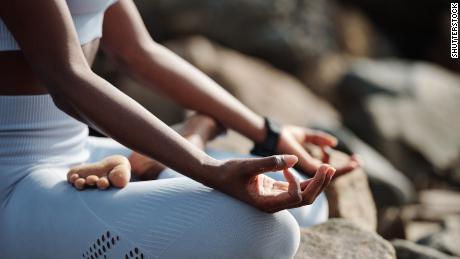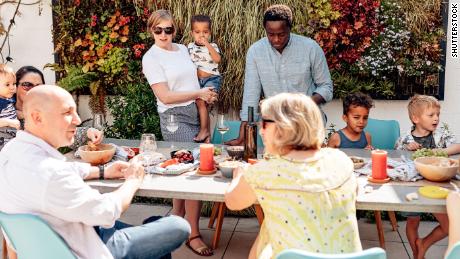(CNN)Back when Travis M. Spencer's daughter was in fourth grade, there were times when she struggled to fall asleep. On those nights, Spencer used to take a few minutes for mindfulness.
First, Spencer invited her to list a few things she was grateful for. That usually included friends or a favorite video game.
"I'm like: 'I'm glad that you're noticing those things,'" said Spencer, a mindfulness educator and the executive director of the Institute of African American Mindfulness in Washington, D.C. "Let's hold onto that feeling and that goodness you're feeling right now. And maybe just take a breath or two as we're falling asleep."
Spencer's work in mindfulness goes beyond the home. He trains teachers and students in practices designed to increase awareness of the present moment. It's an approach that's grown in recent years, with mindfulness programs appearing in classrooms and other education settings.
It helps develop their attention and focus, Spencer said, but also helps kids notice their feelings, physical sensations and the world around them. Such practices could help kids with anxiety, stress and other mental health issues, research shows.
"Mindfulness to me is like a superpower for children," he said. "The more they can feel connected to themselves, to others and to their environment, the more they can thrive and feel supported, and feel like they can do whatever they want to do."
You don't need to be an expert to try mindfulness with kids. Trying mindfulness together can be powerful, said Susan Kaiser Greenland, a mindfulness expert and the author of "Mindful Parent, Mindful Child: Simple Mindfulness Practices for Busy Parents."
"Modeling is key," Kaiser Greenland said. "The true benefit of it is not just bringing in an outside mindfulness teacher like you bring in a piano teacher. Where it really starts is with the parent themselves."
In fact, it can sometimes help for parents to experiment on their own first, Kaiser Greenland said. (You can begin right now with one of these five 1-minute mindfulness techniques.)
Or you can make it a shared endeavor. We've got five great ways to practice mindfulness with your children ŌĆö and Kaiser Greenland said it's never too early (or too late) to start.
1. Try mindful breathing
Breathing is among the most common mindfulness practices. Often, mindful breathing means choosing one sensation ŌĆö such as the breath in your nostrils or the rise and fall of your chest ŌĆö and bringing your attention there.
You can try it for 30 seconds or five minutes. When you get distracted, simply redirect your attention back to the sensation of breath.
With children young enough to have stuffed animals and dolls, Kaiser Greenland recommends a simple breathing practice using a favorite toy.
"They have the stuffed animal on their tummy or on their chest, or someplace where they can really feel the movement of breathing," she said. "Focus in on that sensation of moving the animal up and down with their breathing. That's a wonderful bedtime ritual."
2. Take a gratitude walk
You don't have to sit still to practice mindfulness, said Kaiser Greenland, who recommends inviting kids to join you for a "gratitude walk."
It's something you can try inside or in a peaceful place outside. With your gaze on the ground, simply take slow steps. With every footfall, think of something that you're grateful for.
"It could just be a walk from the kitchen sink to the dining room table and back," she said. If you're doing a mindfulness walk with a younger child, ask them to share their gratitude out loud.
"With every step we say something we're grateful for. I'm grateful for macaroni and cheese, I'm grateful for my puppy, I'm grateful for you, that sort of thing," Kaiser Greenland said. For older kids and adults, the gratitude can be spoken silently if they choose.
3. Shake it off
If your kid is feeling restless, Kaiser Greenland said, it can help to try something even more active.
"First thing you need to do is release some nervous energy," she said. "If you toggle between movement and stillness, that has a more grounding effect."
Kaiser Greenland recommends alternating a minute of movement with a few minutes of stillness. "You just shake to the sound of a beat of a drum, or you shake your arm then shake your leg," she said.
After that, it's time to bring your child's attention to the sensations in their body or things in the immediate environment. "Feel your breathing. Listen to a sound. You feel your feet against the floor," she said. "Then you shake again."
4. Practice noticing
While many mindfulness practices involve looking inward, it's a perspective you can bring to observing the world around you, too.
"If a child is having a hard time, I might ask them to find three blue objects in the room they're sitting in," said Spencer, the mindfulness educator. "Just to give them something external to focus on. That way, they can downshift their nervous system a little bit."
Noticing is a mindfulness practice adults and children can try together, wherever they are. It doesn't have to be visual.
Sometimes, Spencer will invite children to listen to the most distant sound they can identify. Then, he'll shift the focus to sounds in the middle distance. Finally, kids tune into sound in their immediate surroundings.
"Connecting to their senses in that way, I think, is really supportive," he said. "It's really focused on that self-awareness, and building the capacity to pay attention."
5. Stream a guided meditation
Trying out mindfulness doesn't have to be complicated, but it's nice to have help as you start to explore. That's where guided meditations come in, a wide range of mostly free recordings that walk you through mindfulness step by step.
Kaiser Greenland narrates a series of guided audio meditations and exercises for children, designed for specific purposes including quieting, focusing and caring. Children's mindfulness expert and author Annaka Harris also has a free series of mindfulness meditations to try with kids.
"If you're a beginner, it's great to be guided," said Diana Winston, director of mindfulness education at UCLA's Mindful Awareness Research Center. "You have some support and learn how to do it correctly."(The free UCLA Mindful App has guided meditations that Winston helped develop.)
Winston, who has practiced meditation for decades, believes mindfulness practices can be enormously helpful to children. She cites stress reduction, attention building, improved test scores and social-emotional learning as key benefits.
Get CNN Health's weekly newsletter
Sign up here to get The Results Are In with Dr. Sanjay Gupta every Tuesday from the CNN Health team.
But research into mindfulness for children, she said, has a long way to go.
"If the research is young with adults, it's significantly younger with children," said Winston, who is the author of books including "The Little Book of Being: Practices and Guidance for Uncovering Your Natural Awareness."
"It seems to be very positive, but it's not like we should immediately say mindfulness is going to solve all the problems of our failing school systems. It's not like that." Not only that, Winston said that mindfulness practices aren't for every family.
"It's a wonderful tool that can be useful and helpful," she said. "Just like there's no medication that works for everybody. It's the same for meditation. Some people really respond to it and love it, and others don't find it helpful. And that's absolutely fine."









